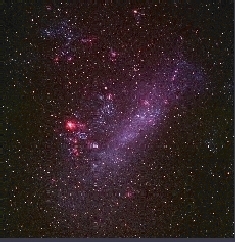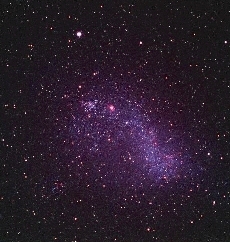

Mission Status Report #50 Star Date: October 2, 2001
FUSE Views the Magellanic Clouds!Caption: The two nearest galaxies to our own Milky Way. (Left) The Large Magellanic Cloud. (Right) The Small Magellanic Cloud. Both of these galaxies are visible to the unaided eye for observers in the southern hemisphere. (Photos courtesy of Axel Mellinger; viewable on the web. (Click images above to see larger versions.)
Hello World, All continues to go extremely well on the FUSE project. All systems are nominal, including the spacecraft, science instrument, and ground systems performance. As FUSE continues operations during the primary scientific mission, over three-quarters of a million seconds of on-target observing time is being obtained each month. These data are processed at Johns Hopkins and then archived at the Multi-Mission Archive at Space Telescope (MAST), where the data can be downloaded by astronomers from all over the world. If you live in the southern hemisphere and look up at the sky late at night this time of year, You would no doubt see two hazy patches of light located well off the plane of the Milky Way. Through binoculars or a small telescope, those patches of light break up into a myriad of stars and nebulas, as shown in the shotos above. They are satellite galaxies of our Milky Way, known as the Magellanic Clouds. The larger of the two is called the Large Magellanic Cloud, or LMC. (I will leave it as an exercise for the reader to figure out what the smaller one is called!) One of the tremendous abilities of FUSE is that it can observe individual stars in these nearby galaxies. You may recall from earlier reports that the previous satellite with capabilities similar to FUSE was the Copernicus satellite in the mid-1970's. Copernicus could only be used to observe stars relatively close to the sun, FUSE is roughly 10,000 times more sensitive than Copernicus, permitting astronomers to observe far out into the universe. FUSE has now been used to observe well over 100 stars in these two nearby galaxies, and astronomers are beginning to share the results of analysis of this huge data set. One of the big bonuses of FUSE observations is that the same data sets can be used for several different purposes. Some astronomers are interested in the light from the stars themselves. Many of these ultraviolet-bright stars are hot, young stars with strong stellar winds, and FUSE observations can detect the hottest portions of these winds. But other astronomers are more interested in using these observations to study the gas and dust in space between us and the star. This material is called the interstellar medium. In this case, the star is just used as a background "light bulb" and the astronomers search for dips (absorptions) in the light from the star caused by intervening material. Some of these dips are due to hot gas, and some to cooler or even cold gas, so all the different kinds of material in space can be studied in the same spectra. To make the bonus even larger, the Magellanic Clouds are moving at several hundred kilometers per second with respect to the Milky Way. Because of the effect called "Doppler shift" the absorption dips from material in the Magellanic Clouds appears in a different place in the spectrum than the corresponding dips from Milky Way gas. Hence, we can study, cold, warm, and hot gas in our Galaxy and in the Magellanic Clouds, plus the star itself, all with the same data set! Wow! This is particularly interesting because the Magellanic Clouds are quite different from each other and from the Milky Way in terms of their chemical abundance make-up, so interesting comparisons can be made. Elsewhere on the project, plans are well underway for "Cycle 3", or the third year of science operations. NASA has recently announced the results of the latest round of proposal requests, and revised inputs to support those observations are pouring in. As long as our satellite remains healthy, we will continue to reap the benefits of this astronomical workhorse in orbit.
Reported by: Bill Blair, Chief of Observatory Operations
|

